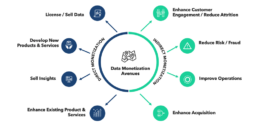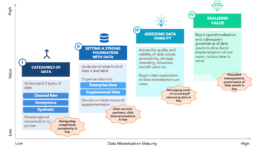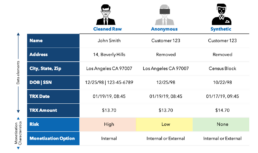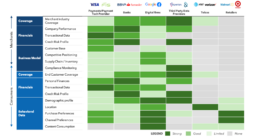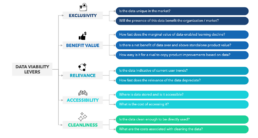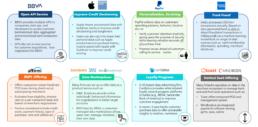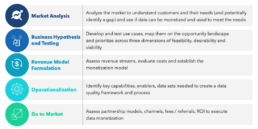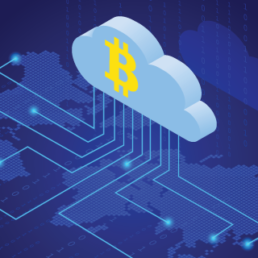Data likely to Unlock Next Phase of Growth
‘5 exabytes of information was created between the dawn of civilization through 2003, but now that much information is created every two days.’ – Eric Schmidt, Executive Chairman, Google
Industry leaders are constantly looking to maximize benefits from what they already have. One way to remain relevant is to utilize a resource ubiquitous, especially for FinTechs & financial institutions i.e., data. Firms have a plethora of rich, growing data on customers, merchants, transactions, products, interactions etc.. This data can be used to improve decision making, customer loyalty, expose new revenue streams, and operate more efficiently.
Firms who prioritize this and find ways to monetize this asset will stand to separate themselves from the pack, as well as solidify existing customer relationships. Even though monetization of data was important pre-pandemic, the ‘new normal’ has multiplied its potential benefits, amplifying both need and opportunity. Here are some trends that explain why now is the right time to invest in a robust data monetization.
Tighter Margins. Traditional sources of revenue, such as core transaction processing fees, are becoming increasingly commoditized, and margins are getting squeezed by inflation, spurring the need for alternative revenue streams.
Unprecedented Digitalization. The last couple of years have led to dramatic acceleration in digital commerce. Businesses are increasingly willing to pay a premium for commerce-enablement services, such as loyalty programs, business intelligence, performance improvements such as enhanced authorization rates, cart optimization, chargeback mitigation etc.. This has created an opportunity to leverage rich financial data in providing such value-added services.
Rise of Embedded Finance. Financial services, rather than being offered as a standalone product, are becoming seamlessly wrapped/embedded into other services, products or technology. Examples include Apple card, Shopify, Amazon Pay, Grab pay etc. In such an ecosystem, financial institutions will need to draw richer insights from customer data tailor offerings/services and remove points of friction.
Digital technologies driving data proliferation. Digital technologies are enabling firms to build entirely new capabilities. For example, mobile devices offer customers anytime, anywhere services providing more context and closer engagement with customers, cloud computing enables firms to launch and scale up services rapidly, open technologies like APIs enable exchange of real time data, AI helps with faster data processing and decision making. This translates to proliferation in data and more avenues and opportunities for monetizing data.
Regulatory challenges. Regulations such as PSD2, Australia’s customer protection laws, consumer-authorized financial data sharing in the U.S., are giving customers more control over their data, forcing transparency, and making a plethora of additional data available to firms who service clients. Open, portable data will erode competitive advantage of incumbent data rich financial institutions. Now is the time for incumbents to rethink how they can monetize internal data, as well as that available through external partnerships, in ways that help them leapfrog the upcoming competition.
Today’s Gold Mine. The estimated market associated with data monetization is expected to be around $11.7B by 2026, a 47.9% growth from $0.7B in 20191. A Forrester Research study also indicated that top-performing companies are 3x more likely to seize new data monetization opportunities than those struggling to grow. This is evident by the numerous mergers and acquisitions of data aggregators such as Nasdaq’s acquisition of Quandl (2018) or London Stock Exchange Group’s whopping $27B acquisition of financial data provider Refinitiv (2021).
While other financial firms, such as banks, are aware of the benefits, most of them have been slow to monetize their data. This is primarily because financial firms have traditionally viewed the custody/protection of their customers data as a responsibility, rather than an asset to be commercialized. This is due to several reasons such as complexities around data sharing (risk and permission-based, audit trails), regulations and compliance (e.g., GDPR, GLBA, CCPA), fear of compromising user privacy, reputational risk and a lack of data monetization expertise.
Knowing Monetization
Data can be monetized directly or indirectly:
Direct Monetization
Direct monetization involves using data to directly generate revenue, either by selling the data itself or selling insights from the data. Although top line driven, direct monetization is less common and all too often overlooked, primarily due to the presumed fear of potential regulatory violations. Some of the common ways of directly monetizing data are:
- License / Sell Data: Provide data access (e.g., aggregated transaction data) to others (own customers or third parties) via data sharing APIs. The buyer can use it for their own analytical efforts, product / service development and research
- Develop New Products / Services: Create new products and services based on aggregated customer data (e.g., Bloomberg’s Evaluated Pricing service, BVAL which supplies pricing daily for over 2.5m securities across all asset classes)
- Sell Insights: Sell processed analytical insights (e.g., Transaction signals can be sold to investment firms; customer purchase trends / analysis to corporations looking to expand business)
- Enhance Existing Product & Services: Leverage data analytics to provide surround products / services with existing offerings (e.g., Mainstreet Insights by Fiserv leverages analytics to optimize businesses of its merchant customers by providing performance reports, sale trends, customer purchase behavior tracking etc.
Exhibit 1. Types of Data Monetization
Indirect Monetization
By contrast, leveraging internal performance data (supplemented with / without external data) to optimize and grow own business is referred to as indirect monetization. It is usually bottom-line driven and helps enhance operational efficiency, improve user experience, reduce risk and compliance issues. This approach is more popular, since businesses of all sizes can make marked operational improvements, and there is usually no red tape to navigate. Some of the ways in which data can be indirectly monetized are:
- Enhance Customer Engagement / Reduce Attrition: Cross sell / up sell products based on analysis of current consumption, customer churn analysis to identify attrition factors, proactively predict at risk customers, design outreach campaigns
- Reduce Risk / Fraud: Test adequacy of risk models, use ML based pattern identification to improve compliance processes, identify fraud opportunities or fraudulent events in progress
- Improve Operations: Tracking of operations KPIs and SLAs to track efficiency, improving product design and processes based on internal performance, customer feedback
- Enhance Acquisition: Enhance targeting for high value leads, increase effectiveness of campaigns, identify new market to grow business
The ideal way to strike the right balance is to start from the source and move to the receiver, i.e., first secure the buy-in from the entity providing the service to the entity consuming the service.
Demystifying Monetization
‘Errors using inadequate data are much less than those using no data at all.’ – Charles Babbage, English Mathematician
By and large, most firms fail to embark on the data monetization journey due to the lack of expertise. While the concept of using data is not new, monetizing data in a strategic and coordinated fashion without exhausting firm’s resources and yet delivering a competitive advantage is the new emerging frontier. Here are critical steps to understand when evaluating a potential data monetization strategy:
Exhibit 2. Data Monetization Stages
I. Categories of Data
A data monetization strategy must consider potential compliance issues inherent to certain data types:
- Raw data may contain personally identifiable information (PII) (e.g., data on where and how a specific person shops at a specific time). It is the most valuable type of data but also has highest risk for threat or misuse
- Anonymized data is the next-most valuable type and has had PII removed. This type of data is much more general than raw data and lacks consumers’ specific details, but it has fewer risks
- Synthetic data is often the ideal data set for monetization as it contains ‘fake data sets that cannot be tracked to the original consumer or firm’. Synthetic data will lack gender information of consumers and will not offer accurate, specific times of purchases, among other factors, but it does provide more data points than anonymous data
The decision to go ahead with direct or indirect monetization will inform the data type to be used. Since direct monetization is external it involves using anonymous/synthetic data whereas indirect monetization can use all three types of data keeping in mind that using cleaned raw data comes with high risk
Exhibit 3. Data Types
II. Setting a Strong Foundation with Data
Not all data available is valuable or saleable in its raw form; it typically requires harmonization with other sources (e.g., market share, meteorological or satellite imagery, commodity markets) to yield valuable insights. Hence, it is important to understand what kind of data is available and how it can be primed for monetization. Once data is identified, they should be mapped to the organizational value chain to explore interconnections, potential opportunities, and risks.
After mapping, data can be organized usually in the form of enterprise-level data (consists of customer/client-generated data, internal performance data) and supplemental data (drawn from external parties/sources). Supplemental data can be added to existing data through various means, such as:
1. Leverage non-traditional alternative data sources to strengthen use cases (including web behavior, mobile-session data, public blogs, social media, and weather forecasts)
2. Use partnerships, platform providers/collaborators to add value to existing data (e.g., Banks can partner with third-party providers like D&B, and Experian to expand merchant industry coverage, and strengthen prospecting, and compliance use cases)
3. Run hackathons and contests to generate new ideas, models, and techniques (e.g., BNP Paribas, Prudential Financial, and Santander sponsor competitions on Kaggle, a data-science hackathon platform)
4. Based on the natural state of the data and the ideal means of supplementation, firms can identify partners who can enhance internally farmed data and prepare it for monetization. For instance, financial services firms have data on consumers/merchants that may not provide a monetization opportunity individually, however when considered in sync with another data set can become more valuable. E.g., Visa and Facebook’s collaboration for P2P payments and e-commerce on WhatsApp provides more excellent data coverage of consumers’ current and potential spending.
Exhibit 4. Monetizable Data with Financial Institutions
III. Assessing Data Viability
After outlining the available data and enriching its value, it is important to evaluate data’s viability for direct / indirect monetization against some of the following questions: (exhibit 5). At this stage, costs of storage, cleaning, governance, consumption and processing of data must be managed against the ever growing and accelerating volume / variety of data.
Once data’s quality has been assessed, the firm can start exploring initial data monetization use cases. Pilots can be conducted on well-vetted use cases to test, learn and gain experience before launching an organization wide data monetization effort.
Exhibit 5. Data Viability Levers
IV. Realizing Value
Once sufficient hands-on experience has been gained, firms can move into rapid operationalization and subsequent governance of data assets to drive faster implementation of use cases, reduce time to value. Acceleration in value will require pro-active management of firm’s data and analytic assets, enhancements as well as strong collaboration and commitment from business and technology.
Industry Success
Both incumbents and growing fintechs are already pursuing innovative data monetization strategies, for example:
Final Thoughts...
Firms need a tailored roadmap to be able to exploit value from data – an asset that never depletes and can be used across an unlimited number of use cases at near zero marginal cost. They must transition from considering data as a cost-accruing asset (with high upkeep linked to storage, data management platforms, etc.) to a revenue-generating asset (either directly contributing to top line or indirectly by using data to improve products/services). Some guiding principles are outlined in Exhibit 6 below:
Exhibit 6. Guiding Principles
...and Considerations
- Navigate Compliance Complexity: Obtain deep understanding of privacy/ compliance requirements (GDPR, CCPA regulations, etc.); work closely with experts when designing new products/ services
- Data Overload / Exhaust: Often companies have too much widely distributed data that it becomes difficult to organize it. Ensuring an appropriate governance and infrastructure in place is key to avoid dealing with data exhaust
- Build the Right Talent Pool: Identify new roles, responsibilities, metrics and risk controls in order to build effective cross-functional collaboration across teams. Also, ensure availability of critical talent including data scientists, data engineers and product managers
- Adopt a Networked Partnership Model: Consider partnerships to enrich data, leverage external analytical expertise and expand use cases and distribution channels
- Consider ROI: Compare the cost of cleaning/sanitizing data and scaling/performing analytics to the expected return. Also, assess the consistency and replicability of those intangible or tangible benefits
- Start Small: Start with a series of small tests / experiments to better monitor customer feedback and sentiment. This will encourage continuous improvement, learning, and fine-tuning of the solution
__________________________________________________________________________________________________________
